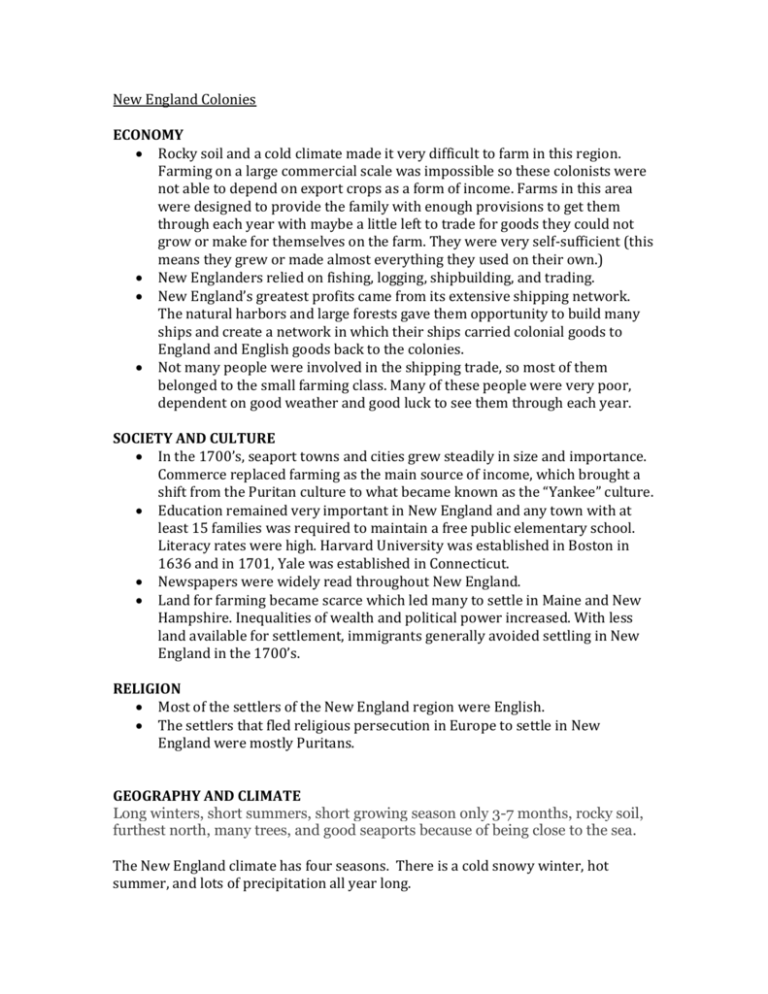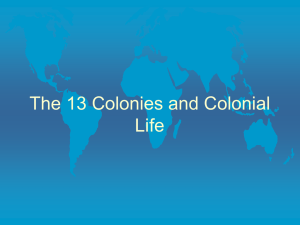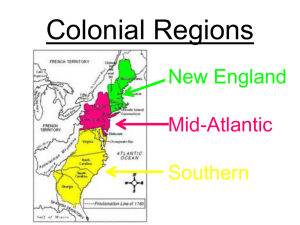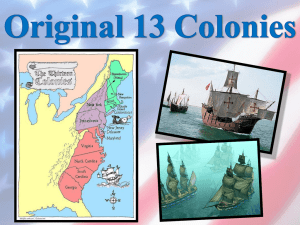3 Colonial Regions Characteristics
advertisement

New England Colonies ECONOMY Rocky soil and a cold climate made it very difficult to farm in this region. Farming on a large commercial scale was impossible so these colonists were not able to depend on export crops as a form of income. Farms in this area were designed to provide the family with enough provisions to get them through each year with maybe a little left to trade for goods they could not grow or make for themselves on the farm. They were very self-sufficient (this means they grew or made almost everything they used on their own.) New Englanders relied on fishing, logging, shipbuilding, and trading. New England’s greatest profits came from its extensive shipping network. The natural harbors and large forests gave them opportunity to build many ships and create a network in which their ships carried colonial goods to England and English goods back to the colonies. Not many people were involved in the shipping trade, so most of them belonged to the small farming class. Many of these people were very poor, dependent on good weather and good luck to see them through each year. SOCIETY AND CULTURE In the 1700’s, seaport towns and cities grew steadily in size and importance. Commerce replaced farming as the main source of income, which brought a shift from the Puritan culture to what became known as the “Yankee” culture. Education remained very important in New England and any town with at least 15 families was required to maintain a free public elementary school. Literacy rates were high. Harvard University was established in Boston in 1636 and in 1701, Yale was established in Connecticut. Newspapers were widely read throughout New England. Land for farming became scarce which led many to settle in Maine and New Hampshire. Inequalities of wealth and political power increased. With less land available for settlement, immigrants generally avoided settling in New England in the 1700’s. RELIGION Most of the settlers of the New England region were English. The settlers that fled religious persecution in Europe to settle in New England were mostly Puritans. GEOGRAPHY AND CLIMATE Long winters, short summers, short growing season only 3-7 months, rocky soil, furthest north, many trees, and good seaports because of being close to the sea. The New England climate has four seasons. There is a cold snowy winter, hot summer, and lots of precipitation all year long. New England has many geographical features! There are rocky coastlines along the Atlantic, harbors, coastal lowlands, and uplands. The many capes, bays, lakes, wetlands, and rivers support the fishing industry. New England also boasts the Appalachian Mountains and Connecticut River Valley! Soil in the New England region is quite rocky, hilly, and shallow. There is also a lot of erosion in this area because of high precipitation rates and nearness to the coast. This makes farming challenging in New England colonies. Middle Colonies ECONOMY Early on these colonies relied on a combination of trade and farming. The most important crop was wheat, with its prices rising steadily during the 1700’s. Trade was equally important in this mixed regional economy. Ships carried grain and flour as exports and brought back British manufactured goods and luxury items though the region’s two major port cities, New York and Philadelphia. By 1775, Philadelphia was the second largest city in the British Empire (second only to London). An industrial economy also grew in this region with the rise of factories, which produced iron, paper, and textiles (cloth). SOCIETY AND CULTURE Farming was important to many in this region with small family wheat farms in Pennsylvania and large commercial estates along the Hudson River in New York. The main source of wealth in these colonies was found in the two major cities, Philadelphia and New York. Cities offered a wide range of occupations and experiences that did not exist in the countryside. Young men could train as apprentices in many trades or the poorest could find work on the docks or as servants. Many also went to work on ships. Slaves were used on New York City’s docks and manual laborers. Free blacks could also make a small living as laborers, servants, and sailors. RELIGION The settlers of mid-Atlantic colonies were from various religious backgrounds; there were Quakers, Lutherans, Congregationalists, Anglicans, Catholics, and Jews. These settlers were as diverse ethnically as they were religiously. Most settlers were Dutch, Swedes, Germans, Finns, and English. GEOGRAPHY AND CLIMATE The climate in the mid-Atlantic region is milder than in New England. There are still four seasons, but the winters are not as cold as in New England; and the summers are not as hot as in the southern region. There is still a lot of precipitation. The mid-Atlantic region is also part of the Appalachian and Adirondack Mountain rages much like New England. It's situated along the east coast so there are lots of navigable rivers, good harbors, and coastal plains. The soil in the mid-Atlantic is very fertile and well suited to farming. The mid-Atlantic colonies produced wheat, barley, rye, corn, and orchard fruits in the very fertile soil. In addition to farmland the mid-Atlantic has plentiful water related resources such as fish and ports. Southeastern Colonies ECONOMIES These colonies were almost entirely agricultural. The mild climate and fertile land provided opportunities to create large plantations which could grow a large variety of cash crops that would not grow in the northern colonies or in England. The first major crop was tobacco. Other major crops included rice, indigo, which is used to make blue dye; wheat and other cash crops; and eventually cotton would become king of the South. These planters were able to build large fortunes on these cash crops while relying on the forced labor of African slaves. The South had several major ports which they used to ship their goods ot the other colonies and to England. They, in turn, received finished goods from England and eventually from the factories in the Middle Colonies. SOCIETY AND CULTURE The South was dominated by the Planter society. People owned large tracks of land called plantations on which a variety of cash crops were grown. Slave labor was used which greatly added to the wealth of the landowners. Colonists who could not afford slaves were not able to compete economically with the plantation owners and eventually moved west. New immigrants, merchants, and skilled craftspeople avoided the region because of the lack of opportunities there and competition from slave labor. Few towns and cities developed in the region with most of it remaining rural. The planter elite concentrated their social life in elegant Charleston, where they moved each summer to avoid the heat and humidity of their plantations. With its beautiful townhouses, theater, and parks, Charleston was the only truly cosmopolitan city of the South. RELIGION Southern settlers were mostly English. The southern colonies were made up of religiously diverse settlers, like in the mid-Atlantic colonies. The settlers were mostly Anglicans, Catholics, Baptists, Lutherans, and Presbyterians. GEOGRAPHY AND CLIMATE The climate in the Southern region is temperate which means it is very warm yearround. The southern region is less mountainous than the other two regions, although there are some smaller mountain ranges like the Blue Ridge and Smokey Mountains in North Carolina. The south is characterized by mostly flat coastal plains with swamps, creeks, and rivers. Estuaries, farmlands, and bays ensure ecosystem diversity in this region. Much like the mid-Atlantic colonies the soil of the southern region is very fertile and is well suited for farming. The southern colonists had access to natural resources including good farmland and lumber.









